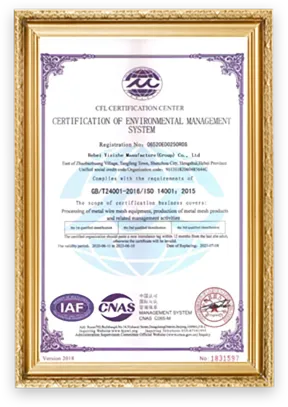Jul . 20, 2024 11:17 Back to list
Exploring the Versatility and Uses of White Chicken Wire in DIY Projects and Home Decor
The Versatility and Utility of White Chicken Wire
White chicken wire, often referred to as poultry netting or hexagonal wire mesh, is a versatile material utilized across various domains. Its aesthetic appeal, coupled with practicality, makes it a popular choice for numerous projects, from agricultural applications to home decor.
Historical Context and Composition
Chicken wire originated in the late 19th century, designed primarily for poultry farming. Farmers sought to create an enclosure that would safely contain chickens while allowing for visibility and ventilation. Made from interwoven galvanized steel wire, the hexagonal openings were intended to keep out predators while allowing the birds’ natural behaviors to manifest. Over time, variations in color and coating emerged, with white chicken wire gaining popularity for its visual appeal and corrosion resistance.
Applications in Agriculture
In agriculture, white chicken wire remains a staple. Farmers utilize it to build secure pens for poultry, protecting birds from predators such as raccoons and foxes. The lightweight yet sturdy design allows for easy manipulation, making it convenient for building temporary or permanent enclosures. Furthermore, it is often employed in garden fencing, deterring larger animals like deer and rabbits from munching on budding plants.
Aside from direct agricultural uses, white chicken wire serves as a medium for crafting protective structures like compost bins
. Its airy design promotes airflow, facilitating the decomposition process while safeguarding the compost from scavengers. This functionality reflects the material's adaptability, as it applies not only to animal husbandry but also to sustainable gardening practices.white chicken wire

Home Decor and Crafting
Beyond its agricultural roots, white chicken wire has found a niche in home decor and crafting. Designers and DIY enthusiasts appreciate the rustic charm it adds to various settings. Picture frames constructed from chicken wire provide a unique way to display photographs, while wreaths made from this material can bring a touch of countryside elegance to home entryways.
Crafting enthusiasts often employ white chicken wire for projects such as homemade organizers, lantern holders, and even decorative walls. The light color enhances its presence, allowing the chicken wire to blend seamlessly with other design elements. It can be painted or embellished, making it a canvass for creativity. Given its ability to adapt to seasonal decorations, it’s not uncommon to find it woven into holiday themes or used in conjunction with flowers and lights.
Environmental Impact and Sustainability
In today’s environmentally conscious world, white chicken wire also contributes to sustainable practices. Many consumers are leaning towards using materials that are long-lasting, reusable, and recyclable. The lifespan of chicken wire, combined with its resistance to corrosion, means fewer replacements and less waste. Furthermore, its applications in gardening support local food production, reducing dependency on mass-produced goods, and encouraging self-sustainability.
Conclusion
In conclusion, the utility of white chicken wire extends far beyond its original purpose. Its diverse applications in agriculture and its aesthetic value in home decor illustrate its versatility. As consumers become more aware of sustainability, products like chicken wire will likely remain relevant. Whether being used to encase a flock of chickens or as a chic organizational solution in a home, white chicken wire continues to embody functionality supported by aesthetic appeal. Its enduring legacy speaks to both the practical needs of yesteryear and the creative possibilities of today.
-
The Role of Field Wire Fence in Grassland Conservation
NewsJul.15,2025
-
Stainless Steel Razor Wire Durability in Coastal Environments
NewsJul.15,2025
-
Enhancing Home Security with Mesh Fences
NewsJul.15,2025
-
Diamond Mesh Wire for Small Animal Enclosures
NewsJul.15,2025
-
Common Wire Nail Tensile Strength Testing for Woodworking
NewsJul.15,2025
-
Barbed Wire Corrosion Resistance Galvanization Techniques
NewsJul.15,2025









